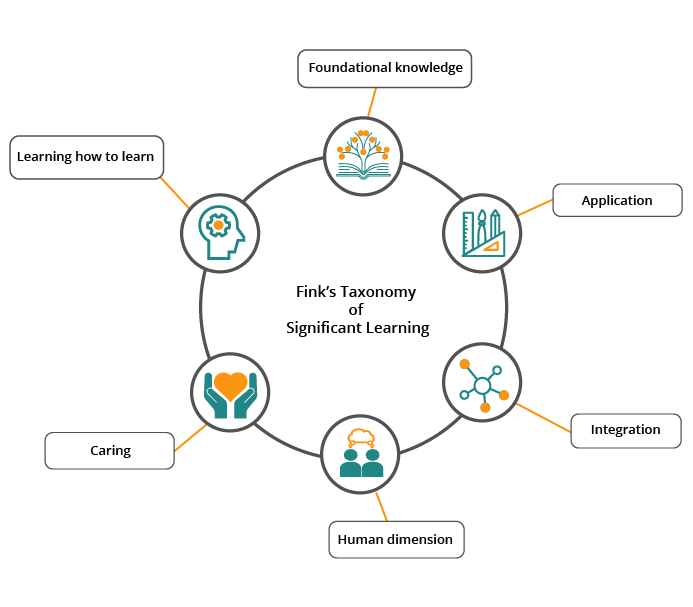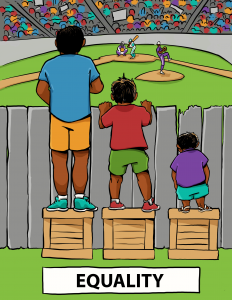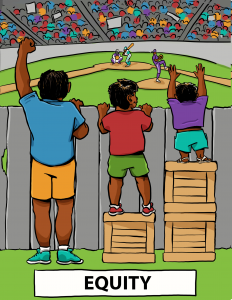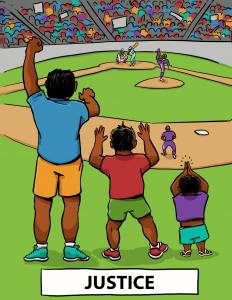Module 2: Designing for inclusivity
2.2 Equity and inclusivity in virtual learning
Key principles: Inclusive course design factors
In Module 1 Designing For Connection, you explored the core components that assist in creating a humanized learning experience beginning with understanding your learners and your own experiences of learning in order to appreciate the joys and vulnerabilities of learning and growing. You also learned about six dimensions of significant learning and three types of connections and interactions that can foster deeper engagement in learning online (see section 1.3. Setting the Stage for Significant and Courageous Learning). Though these all represent humanizing aspects of virtual teaching and learning, it can still be challenging to understand the different dimensions of learners and how the virtual learning space can be designed to be made more welcoming, inclusive, and equitable.
Inclusive course design takes on many forms, but pertains to course design factors such as:
Instructor identity and mindset
-
- Acknowledging your identity as an instructor and how that influences the learning environment.
- Seeking to identify and mitigate the ways that systemic inequalities operate in teaching and learning spaces, affect individuals’ experiences of education, and influence course and curriculum design.
Course atmosphere
- Intentionally cultivating an environment in which all learners are treated fairly, have equal access to learning, feel welcome, valued, challenged, and supported in succeeding academically.
Course materials and resources
- Incorporating materials, resources, and approaches that attend to learners’ different socio-cultural identities and backgrounds.
Assessment
- Purposefully designing, teaching, and assessing in a manner that is contextual, engaging, meaningful, and accessible to all.
- Using varied means of assessment to promote learners academic success and well-being.
These are overlapping concepts, but we will focus in on these elements in this, and upcoming, sections of the module. More specifically,
- this section will focus on developing a foundational language for equity, diversity, and inclusion topics and look inward and reflect on ourselves as instructors or course designers;
- section 2.3 will discuss elements of identity and social justice in virtual learning contexts;
- section 2.4 will consider universal design for learning and ensuring equitable access to online content;
- section 2.5 will explore how to attend to learners’ mental health and wellness in virtual courses; and
- section 2.6 will introduce some steps to begin to decolonize and Indigenize a virtual course.
Quick tips and tricks: Inclusivity as part of significant learning
This module may introduce you to many new concepts, ideas, or perspectives you may have not considered before. However, don’t feel overwhelmed.
It should be emphasized that the principles of humanizing learning, including the course design considerations you have already taken in Module 1 with the six dimensions of significant learning (Fink’s taxonomy: foundational knowledge, application, integration, human dimension, caring, and learning to learn) do set you up for success for inclusive course design!
This module will simply outline different contexts, situations, ideas, and strategies that can help you action the foundations of humanized learning design and help you understand and action what it looks like in a virtual setting.

Key principles: Understanding the language of inclusion
It is important to note that terminology and definitions are always evolving as society grapples with these complex ideas, so we encourage you to approach this as a life-long learning pursuit towards more inclusive teaching. Different institutions, communities, and academic disciplines may use varying language to describe the same or similar concepts related to equity, diversity, Indigenization, decolonization, inclusion, and related ideas—and sometimes choices of language can be politically contentious.
In this course, we are focused less on the “right” label for a given concept and more on the positive social justice outcomes that can result from humanizing learning.
Equity, diversity, and inclusion (EDI)

Equity, diversity, and inclusion (EDI) are common terms used today to frame an intentionally comprehensive approach to a particular goal. In our context, it is equity, diversity, and inclusion in virtual learning.
Consider the following words and our operational definitions.

Equity:
Defined as the removal of systemic barriers and biases (e.g., policies, processes, outcomes), enabling all individuals to have equal opportunity to access and benefit from resources and opportunities. It is important to note that equity does not mean ‘the same’, rather it means accounting for barriers that exist for certain groups for historically or currently underrepresented or marginalized groups and putting in place measures to address and/or remove these barriers.

Diversity:
Defined as the differences in lived experiences and perspectives of people and is meant to convey the existence of and respect for difference. These differences can be positive or negative but can only be created when people come together, and everyone is included. Equity is often considered before diversity, as diversity without equity cannot challenge systemic barriers.

Inclusion:
The active, intentional, and continuous process to address inequities in power and privilege and build a respectful and diverse community that ensures welcoming spaces and opportunities for all to flourish.
You may have started to see acronyms such as EDDI (“equity, diversity, decolonization, and inclusion”) and EDII (“equity, diversity, inclusion, and Indigeneity”) used across organizations. These acronyms differ a bit in meaning, but the general intention is to acknowledge the distinct histories, contexts, and frames of reference between inclusion (historically used to advance the rights of the disability community) and Indigenization/decolonization (used to recognize the ongoing national conversation about reconciliation in Canada). Another variation, EDIIA (equity, diversity, inclusion, Indigeneity, and accessibility), re-emphasizes the accessibility of learning materials, an important consideration for the online space for all learners.
Definitions
Decolonization: is the removal or undoing of colonial elements, while Indigenization can be seen as the addition or redoing of Indigenous elements.
Indigenization: involves going beyond tokenism or gestures of recognition to meaningfully change practices and structures. You will explore this idea further in section 2.6. The Road to Decolonizing and Indigenizing a Virtual Course.
A visual representation of EDDI concepts
Consider the following graphic, which can help you begin to appreciate how these ideas might be actioned in the real world before we delve into these ideas specifically for virtual teaching and learning. You may be familiar with the original image that has been circulating on the internet for some time that was originally created in 2012 by Craig Foehle (see his article “The Evolution of an Accidental Meme”). In this metaphor, we consider three different spectators who wish to watch a baseball game from behind a fence.




Credit: These panels are an original remix of the #the4thBox Equality/Equity/Justice image, a collaboration between Centre for Story-based Strategy & Interaction Institute for Social Change; Artist: Angus Maguire | Image Description(PDF)
Going deeper
You may find the presented glossaries useful to become more comfortable with certain EDI-related terminology.
It is ok to feel unsure about proper usage; as long as you are humble and open to asking questions and receiving answers, most people are happy to clarify for you what a term means to them and how it should be used. Section 2.3. Social justice in virtual learning contexts will also delve deeper into these areas.
- Equity & Inclusion Glossary of Terms: University of British Columbia
- Some useful definitions in Removing Barriers to Online Learning Through a Teaching and Learning Lens (PDF, p. 5)
- Canadian Race Relations Foundation Glossary
- EDI Style Guide: Faculty of Health Sciences, Queen’s University
If you are interested in further exploring #the4thBox, see the Centre for Story-base Strategy’s Why we need to step into #the4thbox free digital resources.
Key principles: Acknowledging unconscious bias and our roles as educators
A way of seeing is also a way of not seeing.
(Kenneth Burke, 1935)
People are psychologically predisposed, to a certain extent, to prefer people who look like us, sound like us, and share our interests (Hamlin, Mahajan, Liberman & Wynn, 2013). This in-group favouritism starts to appear at a young age (~5 years), as children develop social cognition (Abound, 2003) and are reinforced by the attitudes held by adults in their perceived in-group (Bennett et al., 2004). There are several different developmental and social factors that lead to and re-enforce our implicit social biases and in-group favouritism (Aboud & Amato, 2001), which are sometimes operating below the threshold of our awareness and contributing to implicit stereotyping and prejudice (Amodio & Devine, 2006), which together form our unconscious biases.
While the seed of these biases may start early in our development and influence our thoughts and actions pre-consciously, that does not mean we do not have any control over these biases or how they influence our attributions, decisions, and actions (Blair, 2002). There are many psychological and biological processes/urges that happen unconsciously, but we have conscious control over, such as the breath, or how we behave on hunger. We can choose to become aware of these biases through reflection, education, and exposure to more inclusive social norms (Rudman et al., 2001; Sechrist & Stangor, 2001; Sidanius et al., 2006), exposure to individuals and groups who may differ from us (Pettigrew & Tropp, 2006; Page-Gould et al., 2008), and practicing responding in unbiased/non-stereotypical ways (Kawakami et al., 2000; Blair et al., 2001).
In this section of this module, we’ll ask you to reflect on who you are as an instructor to help uncover some of your own unconscious biases as they relate to your teaching.
We all have a “way of seeing” that is rooted in our own experiences and background, and we bring unconscious biases to our work as instructors. Unconscious bias can have unintended effects on learners in a virtual course, as much of what you convey is done in an asynchronous fashion (e.g., through your course outline, video/audio recordings, written text, asynchronous facilitation, etc.) and at times tone or wording can become ambiguous, or learners cannot ask you right away for clarification. Further, your biases may manifest through your selection/curation of course content and assessment design (e.g., what you did and didn’t choose as a required reading, which perspectives or knowledges are privileged over others in your course, what you consider to be acceptable formats to submit for assessment, etc.).
Oftentimes, instructors model new teaching spaces according to their own experiences with (virtual) education and it becomes difficult to envision (virtual) learning in a different way. By becoming aware of our past experiences and thinking about how our unconscious biases affect our teaching and interactions with learners, we can take steps to use more inclusive language and teaching approaches, encourage a more empathetic approach to communication, and promote vocabulary and terminology that respects and values the diversity of the Canadian and global community; a more humanized experience.
This module will focus specifically on exploring different ways of designing your content for your virtual course to broaden your understanding of various intersecting concepts that will allow learners to be included and engaged in all aspects of your course.
Strategies in action: How to mitigate unconscious bias
As a first step, unconscious bias can be interrupted by critical self-reflection and strategies such as
- considering the opposite – take a mental pause by considering evidence supporting the opposite conclusion;
- common identity formation – reflect on points of common identity between you and the other; this common ground can help reduce any negative implicit bias you may have towards them;
- counter stereotypical examples – focus on individuals you admire and respect who are in the same demographic as the person you are directly interacting with/thinking about; and
- perspective-taking – intentionally empathize with the other and take a moment to visualize their life and what they have gone through leading up to this encounter and what their life will be like afterward.
Key principles: Reflective and reflexive practice
Throughout Module 1, and as will continue throughout the course, you have engaged with “Reflect and Apply” activities, which challenge you to think about yourself or the learning you have done, and apply it to your course design and delivery. Most of these activities are focused on professional reflection which is an extremely useful and important exercise. For this module, you may find yourself moving at times into reflexive practice given the subject matter. This adds another dimension to your thinking and actions.
Consider the following two definitions:
Definitions
Reflective practice is the capacity to reflect on action in order to engage in a process of continuous learning and growth. Reflective practice is a process by which you
- pause and think about your practice,
- consciously analyze your decision making, and
- draw on theory, experience, or other learning to relate it to what you did (or didn’t do) in practice.
Reflexive practice is finding strategies to question our own attitudes, thought processes, values, assumptions, prejudices, and habitual actions, in order to better understand our complex roles in relation to others. To be reflexive is to recognize we are active in shaping our surroundings and begin to critically analyze circumstances and relationships rather than merely reacting to them. This process helps review and revise ethical ways of being and relating in our world.
Credit: Allen, W. – Learning for Sustainability
Reflect and apply: Getting to know yourself and your course
In section 1.2. Virtual Learning Contexts and Virtual Learners, you were asked to consider your learners before beginning to think about designing your course. Now, take a moment to reflect on yourself as an instructor in your field, and also as an instructor in the online space.
How to complete this activity and save your work:
Type your response to the questions in the box below. Your answers will be saved as you move forward to the next question (note: your answers will not be saved if you navigate away from this page, refresh the page, or hit the back button). Your responses are private and cannot be seen by anyone else.
When you complete the below activity and wish to download your responses or if you prefer to work in a Word document offline, please follow the steps below:
-
- Navigate through all tabs or jump ahead by selecting “Export” tab in the left-hand navigation.
- Hit “Export document” button.
- Hit “Export” button in the top right navigation.
To delete your answers simply refresh the page or move to the next page in this course.
Hopefully, this exercise provided you with the opportunity to engage in some deep reflections about assumptions related to your course and your perspectives as an educator. In the next sections, we will explore these ideas more deeply and apply course design strategies so that we can make space for all our learners to feel welcome and help them feel included and engaged in our virtual learning spaces.
References and credits
Aboud, F. E. (2003). The formation of in-group favouritism and out-group prejudice in young children: Are they distinct attitudes? Developmental Psychology, 39(1), 48–60.
Aboud, F. E., & Amato, M. (2001). Developmental and socialization influences on intergroup bias. In R. Brown & S. Gaertner (Eds.), Blackwell handbook in social psychology (Vol. 4, pp. 65–85). New York, NY: Blackwell.
Allen, W. (n.d.). Reflective and reflexive practice. Learning for sustainability. https://learningforsustainability.net/reflective-practice/
Amodio, D. M., & Devine, P. G. (2006). Stereotyping and evaluation in implicit race bias: Evidence for independent constructs and unique effects on behavior. Journal of Personality and Social Psychology, 91, 652–661.
Bennett, M., Barrett, M., Karakozov, R., Kipiani, G., Lyons, E., Pavlenko, V., Riazanova., T. (2004). Young children’s evaluations of the ingroup and of outgroups: A multi-national study. Social Development, 13(1), 124–141.
Blair, I. V. (2002). The malleability of automatic stereotypes and prejudice. Personality and Social Psychology Review, 6(3), 242–261.
Blair, I. V., Ma, J. E., & Lenton, A. P. (2001). Imagining stereotypes away: The moderation of implicit stereotypes through mental imagery. Journal of Personality and Social Psychology, 81(5), 828–841.
Burke, K. (1984). Permanence and change (3rd ed.). University of California Press.
Dee Fink, L. (2013). Creating significant learning experiences: An integrated approach to designing college courses. Jossey-Bass.
Hamlin, J. K., Mahajan, N., Liberman, Z., & Wynn, K. (2013). Not like me = bad: Infants prefer those who harm dissimilar others. Psychological Science, 24(4), 589–594.
Kawakami, K., Dovidio, J. F., Moll, J., Hermsen, S., & Russin, A. (2000). Just say no (to stereotyping): Effects of training in the negation of stereotypic associations on stereotype activation. Journal of Personality and Social Psychology, 78 (5), 871–888.
Locksley, A., Ortiz, V., & Hepburn, C. (1980). Social categorization and discriminatory behavior: Extinguishing the minimal intergroup discrimination effect. Journal of Personality and Social Psychology, 39(5), 773–783.
Page-Gould, E., Mendoza-Denton, R., & Tropp, L. R. (2008). With a little help from my cross-group friend: Reducing anxiety in intergroup contexts through cross-group friendship. Journal of Personality and Social Psychology, 95(5), 1080–1094.
Pettigrew, T. F., & Tropp, L. R. (2006). A meta-analytic test of intergroup contact theory. Journal of Personality and Social Psychology, 90(5), 751–783.
Rudman, L. A., Ashmore, R. D., & Gary, M. L. (2001). “Unlearning” automatic biases: The malleability of implicit prejudice and stereotypes. Journal of Personality and Social Psychology, 81(5), 856–868.
Sechrist, G., & Stangor, C. (2001). Perceived consensus influences intergroup behavior and stereotype accessibility. Journal of Personality and Social Psychology, 80(4), 645–654.
Sidanius, J., Sinclair, S., & Pratto, F. (2006). Social dominance orientation, gender, and increasing educational exposure. Journal of Applied Social Psychology, 36(7), 1640–1653.
The “Equity, Diversity, and Inclusion (EDI)” definition and material related to “unconscious bias” on this page is derived from the original work, High Quality Online Courses: How to Improve Course Design and Delivery for your Post-Secondary Learners [link to https://ecampusontario.pressbooks.pub/hqoc/]. The original work is licensed under a CC BY-NC-SA 4.0 International license, except where otherwise noted. This derivative work retains the CC BY-NC-SA 4.0 International license.
The “Reflect and Apply: Getting to Know Yourself and Your Course” material in this resource was adapted from Situational Factors to Consider by Anstey, L., Brant, L., Chen, Y. & Djerbal, Y., copyright Centre for Teaching & Learning, Queen’s University, is shared under a CC-BY-NC-SA 2.0 CA license. for alignment and use within the Humanizing Virtual Learning: A Guide to Creating Connection, Engagement, and Inclusivity course. This derivative work retains the CC-BY-NC-SA 2.0 CA license.
University at Buffalo. (n.d.). Situational Factors. https://www.buffalo.edu/catt/develop/design/situational-factors.html

